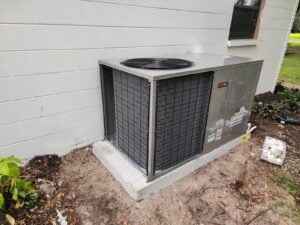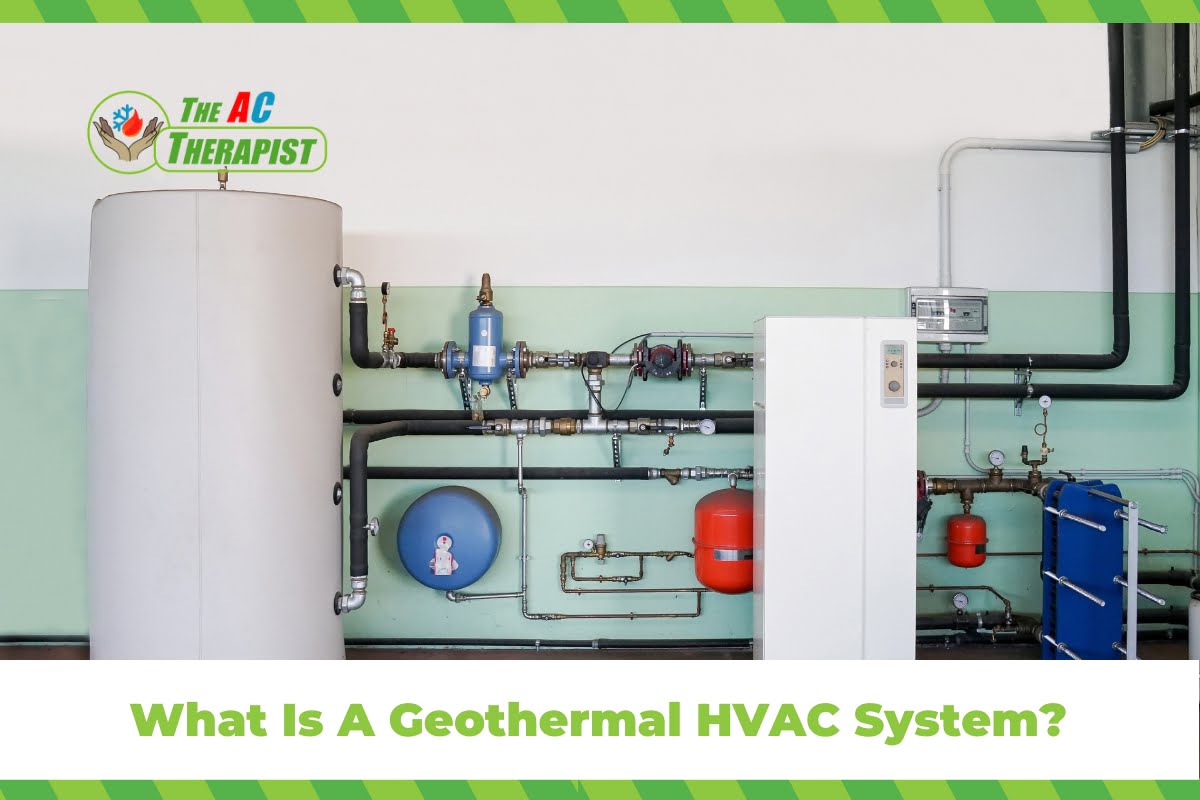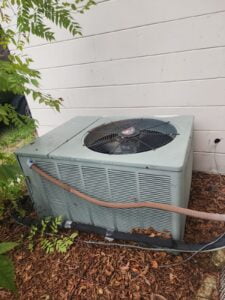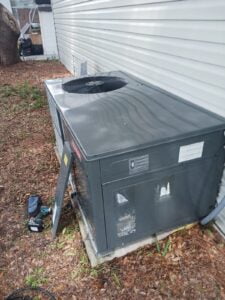What Is A Geothermal HVAC System?
Geothermal heating and cooling systems represent a revolutionary approach to indoor climate control. Unlike traditional HVAC systems that rely on fossil fuels or electricity, geothermal systems tap into the Earth’s stable underground temperatures to heat and cool buildings efficiently and sustainably.
Understanding the Basics
A Geothermal heating and cooling system, also known as a ground source heat pump (GSHP) or geothermal heat pump system, is an energy-efficient and environmentally friendly technology used for heating, cooling, and even providing hot water for residential and commercial buildings. Unlike traditional HVAC systems that rely on fossil fuels or electricity, geothermal systems use the Earth’s natural heat storage capabilities to regulate indoor temperatures.
Environmental Benefits
Geothermal heating and cooling systems offer several significant environmental benefits, making them an eco-friendly choice for indoor climate control. Here are some of the key environmental advantages:
- Reduced Greenhouse Gas Emissions: Geothermal systems use the Earth’s stable temperatures to heat and cool buildings, reducing the need for fossil fuels or electricity. As a result, they produce fewer greenhouse gas emissions compared to traditional heating and cooling systems. This helps combat climate change and lowers the carbon footprint associated with heating and cooling.
- Energy Efficiency: Geothermal systems are highly energy-efficient, with a typical coefficient of performance (COP) between 3 and 5. This means they provide three to five units of heating or cooling energy for every unit of electricity consumed. Their efficiency reduces energy demand and the strain on power grids, contributing to energy conservation.
- Reduced Air Pollution: Since geothermal systems do not burn fossil fuels on-site, they do not release pollutants such as carbon dioxide (CO2), sulfur dioxide (SO2), or nitrogen oxides (NOx) into the air. This improves air quality and reduces the health risks associated with air pollution.
- Preservation of Natural Resources: By relying on the Earth’s renewable thermal energy, geothermal systems reduce the consumption of non-renewable resources like coal, oil, and natural gas. This helps preserve these resources for future generations.
- Lower Water Usage: Unlike some cooling systems that rely on large amounts of water for cooling purposes, geothermal systems have minimal water requirements. This reduces the strain on local water sources and promotes water conservation.
- Minimal Noise Pollution: Geothermal systems operate quietly, with most of the equipment located indoors or underground. This minimizes noise pollution, contributing to a quieter and more pleasant environment.
- Longevity and Reduced Waste: Geothermal HVAC systems have a longer lifespan than traditional systems, often exceeding 20 years with proper maintenance. This longevity reduces the need for frequent replacements and the associated waste generated by discarded HVAC equipment.
- Local Energy Production: Geothermal systems are highly decentralized, allowing energy production at the point of use. This reduces the need for extensive energy transportation and distribution infrastructure, minimizing energy losses during transmission.
- Incentives and Support: Many governments and utility companies offer incentives, rebates, and tax credits to encourage the adoption of geothermal HVAC systems. These incentives can make these systems even more accessible and appealing to homeowners and businesses.
How Geothermal HVAC Systems Work
Geothermal HVAC (Heating, Ventilation, and Air Conditioning) systems, also known as ground source heat pumps (GSHPs), work by harnessing the Earth’s consistent underground temperature to provide energy-efficient heating, cooling, and hot water for buildings. Here’s a detailed explanation of how geothermal HVAC systems work:
- Heat Exchange with the Earth: The Earth’s temperature remains relatively constant a few feet below the surface, regardless of the season. In colder months, the ground is warmer than the outdoor air, and in warmer months, it is cooler. A geothermal system capitalizes on this temperature difference.
- Loop System: The system consists of a loop or a series of pipes buried underground, either horizontally or vertically, or submerged in a nearby water source, depending on available space and geological conditions. This loop is filled with a heat transfer fluid (usually a mix of water and antifreeze).
- Heat Pump Unit: Inside the building, a heat pump unit is installed. This unit contains a compressor and a heat exchanger. The heat pump operates in both heating and cooling modes.
How the system works in different seasons:
- Heating Mode: During the winter, the heat pump extracts heat from the relatively warm Earth via the loop system. The heat pump then compresses this heat and transfers it into the building to provide warmth.
- Cooling Mode: In the summer, the process is reversed. The heat pump removes heat from the building’s interior and transfers it into the Earth through the loop system, providing cooling.
Closed-Loop vs. Open-Loop Systems
Geothermal HVAC systems use either closed-loop or open-loop configurations to exchange heat with the Earth. Each type has its advantages and considerations. Let’s explore the differences between closed-loop and open-loop geothermal systems:
Closed-Loop Geothermal Systems:
- Principle: In closed-loop systems, a continuous loop of pipes, typically made of high-density polyethylene (HDPE), is buried underground. This loop contains a heat transfer fluid, often a mixture of water and antifreeze.
- Installation: Closed-loop systems are installed horizontally in trenches, vertically in boreholes, or sometimes in a coiled fashion in a pond or lake, depending on the available space and geological conditions. Horizontal loops are common in residential installations, while vertical loops are used when space is limited.
- Heat Exchange Process: The heat transfer fluid circulates through the loop and exchanges heat with the Earth. During the heating season, it absorbs heat from the Earth, and during the cooling season, it dissipates heat into the Earth.
- Advantages:
- Closed-loop systems are suitable for a wide range of geological conditions.
- They are less susceptible to external contaminants because the heat transfer fluid is enclosed in a sealed loop.
- Maintenance requirements are generally lower compared to open-loop systems.
- Considerations:
- Installation costs can be higher, especially for vertical loop systems.
- Proper spacing and sizing of loops are critical for optimal performance.
- The loop installation process may disrupt landscaping and require excavation.
Open-Loop Geothermal Systems:
- Principle: Open-loop systems use groundwater from a nearby well, pond, lake, or other water source as the heat exchange medium.
- Installation: These systems require a reliable and accessible water source, such as a well that can provide a sufficient flow rate. Water is extracted from the source, passed through the heat pump, and then discharged back into the environment or returned to the source.
- Heat Exchange Process: Water from the open source absorbs or dissipates heat in the heat pump unit depending on the season, similar to closed-loop systems.
- Advantages:
- Open-loop systems are often more cost-effective to install because they don’t require as much excavation.
- They can be highly efficient due to the consistent temperature of the water source.
- Considerations:
- Suitable water sources must be available and meet local regulations.
- Water quality and chemistry need to be monitored, as certain minerals or contaminants can affect system performance.
- Water discharge and return must comply with local environmental regulations.
- Open-loop systems may require more maintenance and filtration to prevent clogs or scaling.
Choosing between closed-loop and open-loop geothermal systems depends on factors like property size, geological conditions, water availability, and budget. Closed-loop systems are versatile and work well in various settings, while open-loop systems can be cost-effective but require a reliable and appropriate water source. Consulting with a qualified geothermal HVAC installer or engineer is essential to determine the most suitable system for a specific location and application.
Geothermal HVAC Installation
Geothermal HVAC installation is a meticulous process that involves several crucial steps to ensure the efficient and reliable operation of the system. Here is a breakdown of the installation process:
1. Site Assessment: Before installation begins, a thorough site assessment is conducted. This assessment involves evaluating the property’s geological characteristics, available space for the loop system, and proximity to a suitable water source (for open-loop systems). The assessment helps determine the most suitable type of geothermal system (closed-loop or open-loop) and the optimal loop configuration (horizontal, vertical, or pond/lake).
2. Loop System Installation:
For Closed-Loop Systems:
- Horizontal Loop: Trenches are excavated in the ground, typically at depths of 6 to 10 feet, depending on local frost depth and climate conditions. Pipes containing the heat transfer fluid are placed in these trenches, backfilled with soil, and connected to the heat pump unit inside the building.
- Vertical Loop: Vertical boreholes are drilled into the ground, reaching depths of 100 to 400 feet or more. Pipes are inserted into these boreholes and grouted in place, connecting to the heat pump unit.
For Open-Loop Systems:
- A well is drilled to access a groundwater source or a suitable water body, such as a pond or lake.
- A pump is installed to extract water from the source and transport it to the heat pump unit.
- After exchanging heat in the heat pump unit, the water is either discharged back into the environment or returned to the source according to local regulations.
3. Heat Pump Installation: Inside the building, the heat pump unit is installed. This unit contains critical components such as the compressor, heat exchanger, and refrigerant system. The heat pump is connected to the loop system (either closed-loop pipes or open-loop water source) to facilitate the exchange of heat between the loop and the building’s HVAC system.
4. Ductwork and Distribution System: If the geothermal system is being installed as part of a new construction project or as a replacement for an existing HVAC system, ductwork and distribution systems are designed and installed to distribute heated or cooled air throughout the building. Proper design and installation of these components are essential for even and efficient temperature distribution.
5. Control and Monitoring Systems: Control and monitoring systems are integrated into the installation to ensure the system operates efficiently. These systems may include thermostats, sensors, and programmable controllers that allow users to set desired temperatures and monitor system performance. Proper calibration and configuration of these systems are crucial for optimal operation.
6. Commissioning and Testing: After installation, the geothermal HVAC system undergoes thorough commissioning and testing. This process verifies the correct and efficient operation of the system. Technicians assess the system’s performance and make any necessary adjustments or fine-tuning to optimize efficiency.
7. Training and User Education: Building owners and occupants are provided with training and educational materials on how to operate and maintain the geothermal HVAC system for optimal performance and longevity. This includes guidance on setting temperature controls and performing routine maintenance tasks.
8. Maintenance Plan: A maintenance plan is often recommended to ensure the system continues to operate efficiently and reliably over time. Regular checkups, filter replacements, and other maintenance tasks are scheduled to keep the system in peak condition.

Geothermal HVAC System Maintenance
Maintaining a geothermal HVAC (Heating, Ventilation, and Air Conditioning) system is essential to ensure its long-term efficiency and trouble-free operation. Proper maintenance helps prevent issues, maximizes energy savings, and extends the system’s lifespan. Here are key maintenance tasks for geothermal HVAC systems:
1. Regular Filter Replacement: Filters in the air handler or ductwork should be checked and replaced as needed. Dirty filters restrict airflow, reducing system efficiency.
2. Inspect Heat Pump Components: Periodically inspect the heat pump unit for any visible damage, loose wires, or unusual noises. Ensure that the unit is clean and free of debris.
3. Loop System Inspection: If you have a closed-loop system, have the loop system inspected by a professional at regular intervals. This involves checking for leaks, ensuring proper pressure, and assessing the overall condition of the loop pipes.
4. Lubrication and Fan Maintenance: Lubricate fan motors and bearings as recommended by the manufacturer. Clean fan blades and blower assemblies to maintain proper airflow.
5. Check Refrigerant Levels: For systems with refrigerant, have a technician check and, if necessary, recharge the refrigerant to maintain optimal performance. Refrigerant leaks should be repaired promptly.
6. Inspect Electrical Connections: Check and tighten electrical connections in the heat pump unit. Loose connections can lead to system inefficiencies and potentially hazardous conditions.
7. Thermostat Calibration: Ensure that the thermostat is calibrated correctly. Programmable thermostats should have their settings adjusted seasonally for optimal comfort and energy savings.
8. Duct Inspection and Cleaning: If you have a forced-air distribution system, inspect and clean the ductwork periodically. Clean ducts improve indoor air quality and system efficiency.
9. Water Source Maintenance (Open-Loop Systems): If you have an open-loop system using a water source, monitor water quality and ensure that it meets system requirements. Water quality issues can affect the system’s performance.
10. Schedule Professional Maintenance: Consider scheduling professional maintenance annually or as recommended by the system manufacturer or installer. Professional technicians can perform comprehensive checks, verify system settings, and address any potential issues.
11. Inspect and Clean Heat Exchangers: If your geothermal system includes a desuperheater for domestic hot water, inspect and clean the heat exchanger to maintain efficient water heating.
12. Monitor System Performance: Regularly monitor the system’s performance, including heating and cooling cycles, temperature differentials, and energy usage. Unusual patterns or changes may indicate a need for maintenance.
13. Maintain Landscaping: If you have a horizontal loop system, maintain the landscaping above the loop field. Avoid planting trees or shrubs with deep roots that could damage the loop pipes.
14. Keep Records: Maintain a maintenance log that includes dates of service, tasks performed, and any issues noted. This log can help track the system’s history and identify trends.
Regular maintenance not only ensures efficient and reliable operation but also helps identify and address potential issues before they become major problems. Consulting with a qualified HVAC technician or geothermal specialist for professional maintenance is advisable to ensure that your geothermal system continues to provide energy-efficient heating and cooling for years to come.
Comparing Geothermal HVAC to Traditional Systems
Comparing geothermal HVAC (Heating, Ventilation, and Air Conditioning) systems to traditional HVAC systems reveals several key differences and advantages. Here’s a comprehensive comparison of the two:
1. Energy Efficiency:
- Geothermal HVAC: Geothermal systems are highly energy-efficient. They typically have a coefficient of performance (COP) between 3 and 5, meaning they provide three to five units of heating or cooling for every unit of electricity consumed. Their efficiency remains consistent regardless of outdoor temperatures.
- Traditional HVAC: Traditional systems, such as furnaces and air conditioners, have lower efficiency ratings, especially when outdoor temperatures are extreme. They rely on the combustion of fossil fuels or electrical resistance heating, which can be less efficient.
2. Operating Costs:
- Geothermal HVAC: While the upfront installation cost of a geothermal system can be higher, the long-term operating costs are lower due to high energy efficiency. Lower electricity consumption translates to reduced utility bills, leading to significant cost savings over time.
- Traditional HVAC: Traditional systems can have higher operating costs, especially when using electricity or fossil fuels for heating and cooling. Fuel prices can fluctuate, impacting overall expenses.
3. Environmental Impact:
- Geothermal HVAC: Geothermal systems have a minimal environmental footprint. They use renewable energy from the Earth, reducing reliance on fossil fuels and lowering greenhouse gas emissions. This makes them a more environmentally friendly choice.
- Traditional HVAC: Traditional systems that use fossil fuels release carbon emissions and contribute to air pollution, impacting air quality and contributing to climate change. Even electric resistance heating systems may rely on electricity generated from fossil fuels.
4. Longevity and Durability:
- Geothermal HVAC: Geothermal systems are known for their durability and longevity. The underground components can last for decades, often exceeding 50 years, while the indoor components typically last 20-25 years with proper maintenance.
- Traditional HVAC: Traditional systems have a shorter lifespan, often requiring replacement or major repairs within 15-20 years. This can result in higher long-term costs.
5. Consistency of Operation:
- Geothermal HVAC: Geothermal systems provide consistent heating and cooling year-round. They are not affected by external weather conditions and maintain efficiency even during extreme cold or hot temperatures.
- Traditional HVAC: Traditional systems may struggle to maintain desired temperatures during temperature extremes, leading to discomfort and increased energy consumption.
6. Space Requirements:
- Geothermal HVAC: Geothermal systems require space for the loop system, whether it’s horizontal trenches or vertical boreholes. The amount of space required depends on the system’s configuration and property size.
- Traditional HVAC: Traditional systems, especially central air conditioners and furnaces, also require space for equipment installation, but the space requirements are typically more predictable and can vary based on system type and size.
7. Maintenance:
- Geothermal HVAC: Geothermal systems generally require less maintenance than traditional systems. Regular checkups and occasional loop system inspections are recommended to ensure optimal performance.
- Traditional HVAC: Traditional systems may require more frequent maintenance, including filter replacements, duct cleaning, and furnace or air conditioner tune-ups.
Your Trusted Partner for Complete HVAC Comfort
In conclusion, at The AC Therapist, we take pride in delivering top-notch residential and light commercial HVAC services in the Tampa Bay area. While we don’t currently offer geothermal HVAC systems installation, we are dedicated to providing you with the best solutions for your air conditioning, heating, and indoor air quality needs.
Our team is committed to ensuring your comfort, energy efficiency, and peace of mind. Whether it’s AC repair, installation, maintenance, duct cleaning, or any other HVAC service, you can rely on us for professional and reliable solutions.
If you have any questions about our services or need assistance with your HVAC system, please don’t hesitate to get in touch. We’re here to serve you and keep your indoor environment at its best. Thank you for choosing The AC Therapist for all your HVAC needs.











